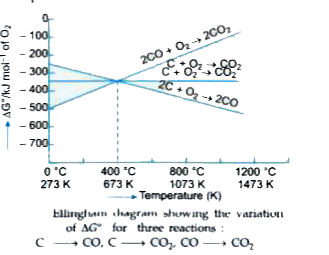Out of C and CO, which is a better reducing agent at 673K?
Carbon reacts with oxygen in one of the following two ways :
C(s)+O2(g)→CO2(s) ...........(i)2C(s)+O2(g)→2CO(g) ...........(ii)
The CO produced in (ii) can also react with O2 to form CO2
2CO(g)+O2(g)→2CO2(g) ..........(iii)
In the first reaction, the volume of CO2 produced is almost the same as that of O2 used, therefore, △S is very small and △G0 does not change with temperature. Thus, the graph of △G0 against T is almost horizontal (see the figure).
The second reaction produces two volumes of CO for every one volume of O2 used. Thus, △S is positive and hence △G0 becomes increasingly negative as the temperature increases. △G=△H−T△S. Consequently, its line on the Ellingham diagram slopes downwards. The third reaction produces two volumes of CO2 for every three volumes of reactants used. Thus, △S is −ve and hence △G0 becomes increases. Consequently, its line on the Ellingham diagram slops upwards. The three lines cross at 673K (see Fig. 6.3). Below this temperature, formation of CO2 is energetically more favourable and above this temperature, formation of CO is energetically more favourable. In other words, below 673 K, both C and CO can act as reducing agents but since CO can be more easily oxidised to CO2 than C to CO2, therefore, below 673 K, CO is a more effective reducing agent than C. Above 673 K, △G vs T curve for CO→CO2 lies above the corresponding curves for both C→CO2 and C→CO, therefore C is a better reducing agent than CO.

Related Playlists
- BOOK - U-LIKE SERIESCHAPTER - GENERAL PRINCIPLES AND PROCESSES OF ISOLATION OF ELEMENTSEXERCISE - CASE BASED/SOURCE-BASED INTEGRATED QUESTIONS15videos
GENERAL PRINCIPLES AND PROCESSES OF ISOLATION OF ELEMENTS
- BOOK - U-LIKE SERIESCHAPTER - GENERAL PRINCIPLES AND PROCESSES OF ISOLATION OF ELEMENTSEXERCISE - MULTIPLE CHOICE QUESTIONS20videos
GENERAL PRINCIPLES AND PROCESSES OF ISOLATION OF ELEMENTS
- BOOK - U-LIKE SERIESCHAPTER - GENERAL PRINCIPLES AND PROCESSES OF ISOLATION OF ELEMENTSEXERCISE - SELF ASSESSMENT TEST7videos
GENERAL PRINCIPLES AND PROCESSES OF ISOLATION OF ELEMENTS
- BOOK - U-LIKE SERIESCHAPTER - EXAMINATION PAPER 2020EXERCISE - SECTION D15videos
EXAMINATION PAPER 2020
- BOOK - U-LIKE SERIESCHAPTER - HALOALKANES AND HALOARENES EXERCISE - SELF ASSESSMENT TEST ( SECTION B)1videos
HALOALKANES AND HALOARENES
Similar Questions
Out of C and CO, which is better reducing agent at 673 K ?
View SolutionWhich is better reducing agent at 983 K, C or CO ?
View SolutionOut of C and CO, which is a better reducing agent at lower temperature range in the blast furnace to extract iron from the oxide ore?
View SolutionOut of C and CO, which is a better reducing agent at the lower temperature range in the blast furnace to extract iron from the oxide ore?
View Solution(a) Which solution is used for the leaching of silver metal in the presence of air in the metallurgy of silver ?
(b) Out of C and CO, which is a better reducing agent at the lower temperature rangein the blast furnace to extract iron form the oxide ore ?View Solution(a) Which solution is used for the leaching of silver metal in the presence of air in the metallurgy of silver ?
(b) Out of C and CO, which is a better reducing agent at the lower temperature rangein the blast furnace to extract iron form the oxide ore ?View SolutionOut of C and CO, which is a better reducing agent for ZnO?
View SolutionOut of C and CO, which is better reducing agent for ZnO?
View SolutionOut of C and CO, which is a better reducing agent at 673K?
View SolutionOut of C and CO, which is better reducing agent for ZnO?
View Solution

